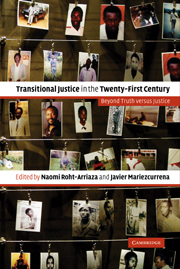Book contents
- Frontmatter
- Contents
- List of contributors
- Acknowledgments
- The new landscape of transitional justice
- Part I Truth, justice, and multiple institutions
- Introduction to Part I
- 1 The Sierra Leone Truth and Reconciliation Commission
- 2 Transitional criminal justice in Sierra Leone
- 3 The Peruvian Truth and Reconciliation Commission and the challenge of impunity
- 4 The “Mexican solution” to transitional justice
- 5 No justice, no peace: Discussion of a legal framework regarding the demobilization of non-state armed groups in Colombia
- 6 Hybrid attempts at accountability for serious crimes in Timor Leste
- Part II Levels of justice: Local, national and international
- Index
Introduction to Part I
Published online by Cambridge University Press: 05 June 2012
- Frontmatter
- Contents
- List of contributors
- Acknowledgments
- The new landscape of transitional justice
- Part I Truth, justice, and multiple institutions
- Introduction to Part I
- 1 The Sierra Leone Truth and Reconciliation Commission
- 2 Transitional criminal justice in Sierra Leone
- 3 The Peruvian Truth and Reconciliation Commission and the challenge of impunity
- 4 The “Mexican solution” to transitional justice
- 5 No justice, no peace: Discussion of a legal framework regarding the demobilization of non-state armed groups in Colombia
- 6 Hybrid attempts at accountability for serious crimes in Timor Leste
- Part II Levels of justice: Local, national and international
- Index
Summary
The authors in Part I look at the different ways in which the quest for truth and justice can be carried out at the same time. These experiences use a variety of institutional designs to create an authoritative and official record of past events, to criminally prosecute the worst offenders, to give victims a platform, and to recommend changes that will dignify victims, educate bystanders, and ensure that “never again” becomes a reality.
In Chapter 1, William Schabas discusses the Sierra Leone experience from his vantage point as a member of that country's Truth and Reconciliation Commission. Schabas concludes that, despite many fears and some real, and unexpected, problems, there is no inherent reason why a TRC cannot exist side by side with criminal trials, in this case the Special Court for Sierra Leone. Although the two institutions had different mandates and were created at different times, their goals were complementary, and by and large each pursued those goals unhindered. Schabas also raises questions about the advisability of retracting an already-granted amnesty, and about the degree of real change in political culture needed to support transitional justice endeavors.
In Chapter 2, Sigall Horovitz looks at Sierra Leone from the perspective of a former staff member of the Special Court. She describes the operation of the Court, and analyzes its strengths and weaknesses in light of prior experiences with international criminal tribunals, especially in terms of local ownership and long-term strengthening of local justice.
- Type
- Chapter
- Information
- Transitional Justice in the Twenty-First CenturyBeyond Truth versus Justice, pp. 19 - 20Publisher: Cambridge University PressPrint publication year: 2006
- 1
- Cited by

